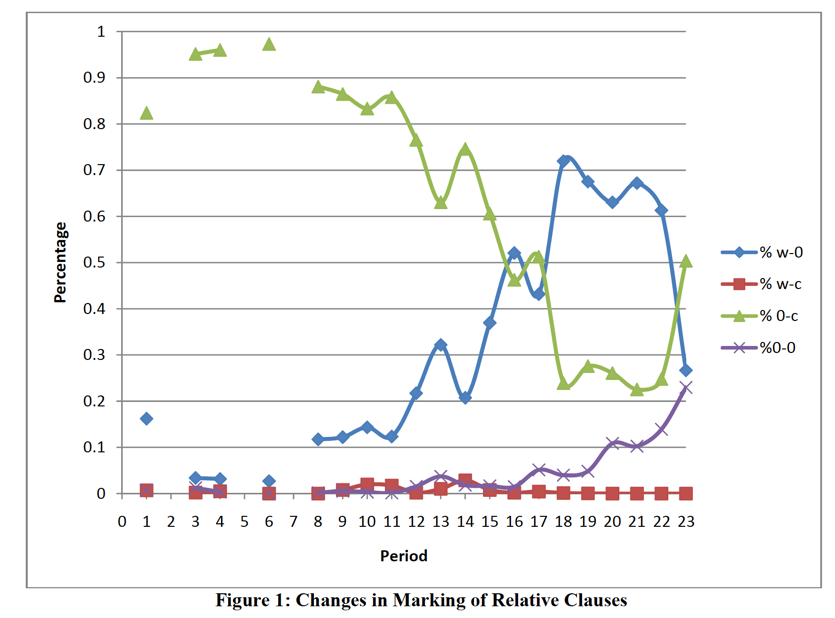Behind "The Humble Petition of WHO and WHICH"
« previous post | next post »
A few days ago, I reprinted Richard Steele's "The Humble Petition of WHO and WHICH", where he voices their complaint that "We are descended of ancient families, and kept up our dignity and honour many years, till the jack-sprat THAT supplanted us". This item appeared in The Spectator for May 30, 1711, and Joan Maling emailed me to ask what we know about the relative frequency of various relative pronouns across time.
A brief inquiry turned up Ariel Dirtani, "Historical Developments in the Marking of English Relative Clauses", Penn Linguistics Colloquium 2008, where I found this interesting graph:
The time periods on the horizontal axis are:
Period 1: 1150-1175
Period 2: 1176-1200; no data
Period 3: 1201-1225
Period 4: 1226-1250
Period 5: 1251-1275; no data
Period 6: 1276-1300
Period 7: 1301-1325; no data
Period 8: 1326-1350; all data from the Ayenbite, a translation from French with some aberrancies
Period 9: 1351-1375
Period 10: 1376-1400
Period 11: 1401-1425
Period 12: 1426-1450
Period 13: 1451-1475
Period 14: 1476-1500
Period 15: 1501-1525
Period 16: 1526-1550
Period 17: 1551-1575
Period 18: 1576-1600
Period 19: 1601-1625
Period 20: 1626-1650
Period 21: 1651-1675
Period 22: 1676-1700
Period 23: 1701-1710
Note that the green curve (proportion of 0-c, i.e. "that") falls from nearly 100% in 1300 to a bit more than 20% in 1600, while the blue curve (proportion of wh-0, i.e. "who", "which", etc.) rises during the same period from almost nothing to more than 70%.
Then things stay about the same until period 23, 1701-1710, during which "that" rises abruptly to 50% and the wh-words fall to around 25%. And this is the decade just before Steele's Complaint!
It would be good to look at a larger sample, to compare across registers and regions, and to follow the pattern through to the present. And to relate it all to the modern sport of which-hunting, we should break things down by the type of relative clause involved.

Jonathon Owen said,
August 28, 2015 @ 11:10 am
Interesting, but could you explain what the four lines represent in a little more detail? Apparently 0-c is "that" and wh-0 is "who"/"which", but what are the other two?
[(myl) wh is "who" or "which" or other wh-word; c is "that"; so
w-0 is "which" ("the book which I read")
w-c is "which that" ("the book which that I read")
0-c is "that" ("the book that I read")
0-0 is nothing ("the book I read")
]
Glenfarclas said,
August 28, 2015 @ 1:12 pm
As I mentioned in a late comment to the previous post, that essay is by Richard Steele, not Joseph Addison. You'll see that it's signed "R." at the end, which was Steele's particular mark. Addison signed his essays with C, L, I, or O. (See, e.g., here.)
[(myl) Thanks for the correction — I'll fix the author references.]
Glenfarclas said,
August 28, 2015 @ 1:13 pm
Apologies; the link for "here" didn't work, but it's: https://books.google.com.ar/books?id=VQRAAAAAYAAJ&pg=PR17&lpg=PR17&dq=addison+spectator+clio&source=bl&ots=tMWIPT_jjl&sig=B3EY3YXNAFtQmOzNQILFqrUGhYE&hl=en&sa=X&redir_esc=y#v=onepage&q=addison%20spectator%20clio&f=false
Jerry Friedman said,
August 28, 2015 @ 4:46 pm
(The post still has "Addison's Complaint", though.)
This post led me to look at the original essay and some others, including the reply of That.
In another essay from the Spectator I found these lines, which might be of interest in Language Log.
"There are several arts which all men are in some measure masters of, without having been at the pains of learning them. Everyone that speaks or reasons is a grammarian and a logician, though he may be wholly unacquainted with the rules of grammar or logic, as they are delivered in schools and systems."
George Gibbard said,
August 28, 2015 @ 7:57 pm
not strictly relevant, but I noticed the odd choice of relative in:
“I love Brazilians, especially Brazilian women, which are absolutely incredible,” Mr. Trump said in a 2014 interview with Veja, a Brazilian magazine.
http://www.nytimes.com/2015/08/21/world/americas/donald-trump-hotel-rio-immigration.html?_r=0
Veja is written in Portuguese, so probably someone at the New York Times is either messing with us or relying on a bad translator.
maidhc said,
August 29, 2015 @ 2:04 am
George Gibbard: Is he referring to people or the nether hairstyle? Could be an omitted preposition ("especially on Brazilian women").
Paulo said,
August 30, 2015 @ 5:54 pm
I've increasingly often been seeing stuff like "there were lots of people there, some of which were underage". I assume it's whom-avoidance, though that wouldn't apply to the Brasileiras cited.